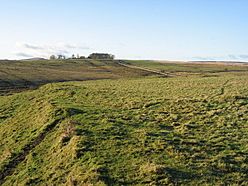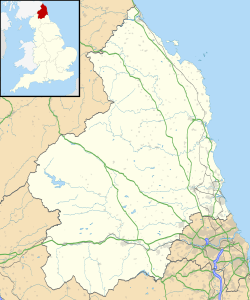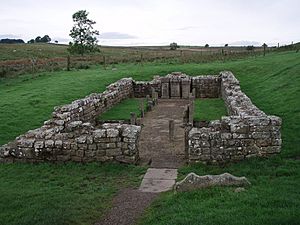Carrawburgh facts for kids
Quick facts for kids Carrawburgh |
|
|---|---|

Southern rampart of Brocolitia
|
|
| Alternative name(s) | Brocolitia, Procolita, or Brocolita |
| Place in the Roman world | |
| Province | Britannia |
| Stationed military units | |
| — Cohorts — | |
|
|
| Location | |
| Coordinates | 55°02′10″N 2°13′23″W / 55.036°N 2.223°W |
| County | Northumberland |
| Country | England |
| Reference | |
| UK-OSNG reference | NY858712 |
| Site notes | |
| Controlled by | English Heritage |
Carrawburgh is a place in Northumberland, England. Long ago, it was a Roman fort called Brocolitia. This fort was part of Hadrian's Wall, a famous barrier built by the Romans. The name Brocolitia might mean 'badger holes'.
The fort was about 1.5 hectares (3.5 acres) in size. It was home to Roman auxiliary soldiers. These were soldiers who were not full Roman citizens. The fort was built across the vallum, a ditch and mound system. This shows it was built after the main wall and vallum.
Today, you can mostly see the fort's earthworks. These are the raised areas of earth that show where the walls once stood. The northern part of the fort and the Wall itself were removed. This happened when a military road was built in the 1700s.
In the late 1800s, an archaeologist named John Clayton dug up parts of the site. He found a Roman bath-house outside the fort. He also found a corner tower of the fort.
Historians have found many Roman inscriptions at Carrawburgh. These stone carvings tell us which army units were stationed there.
- The First Cohort of Aquitani was there around AD 133.
- The Cohors I Tungrorum was present between AD 122 and 138.
- The Cohort I Cugernorum was there in the late 2nd century.
- The First Cohort of Batavians was stationed there in the 3rd and 4th centuries.
- The First Cohort of Frisiavones also served at Brocolitia. An altar stone shows that a soldier named Optio Maus made a promise to the goddess Coventina.
Contents
Roman Temples and Shrines
Archaeologists have found three Roman religious sites near the fort. They are in a marshy area near a small stream. This stream flows into the River South Tyne.
The Mithraeum
About 80 meters from the fort, you can see the remains of a mithraeum. This was a temple for the Roman god Mithras. It was found in 1949 and dug up in 1950. It is one of the northernmost Mithras temples ever found.
Like most Mithras temples, it was built to look like a cave. It had an entrance room and a main hall. The main hall had raised benches along the sides. These benches were for people to sit on during ceremonies.
The temple was built in three stages. The first stage was small. Later, it was made bigger and had fancy decorations. This second stage lasted for most of the 3rd century. It was damaged around AD 296-297, but the stone parts stayed. The temple was then fixed up for a third stage.
Coins found at the site suggest the temple was not used much after AD 308. The main image of Mithras was taken away. Other than a fallen roof, the temple was found almost as the Romans left it. You can still see the foundations of the temple today. A copy of the temple is on display at the Great North Museum in Newcastle upon Tyne.
Shrine to the Nymphs
Right in front of the Mithras temple was another shrine. It was called the Shrine to the Nymphs and Genius Loci. This shrine might have been an open-air area with a paved floor. An altar found here was dedicated around AD 213. It was likely built when the Mithras temple was not in use. Later, parts of this shrine were used to build the second Mithras temple. This shrine was also damaged around AD 300.
Coventina's Well
The third site was 'Coventina's Well'. This was a place to worship the goddess Coventina. It was discovered in 1876. The well is famous for the many items found inside it. Over 13,000 coins, sculptures, and altars were pulled from the well.
The well was built around AD 128-133. It helped control the water level in the area. Later, it became linked with Coventina. The worship of Coventina was most popular in the late 2nd to early 3rd centuries. This was when the Batavian soldiers were at the fort.
Today, you cannot see the remains of the Nymphs' shrine or Coventina's Well.
Who Owns Carrawburgh Now?
Carrawburgh fort is a protected historical site. For many years, it was privately owned. In January 2020, the fort was given to the nation. It is now owned by Historic England and managed by English Heritage.



